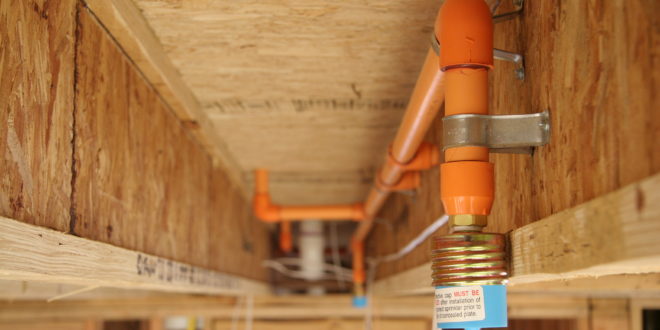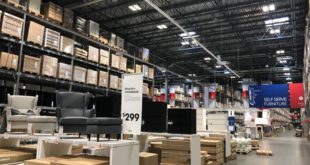Exciting Changes Ahead
There is always a lot of excitement surrounding the issuance of a new National Fire Protection Association (NFPA) standard. This fall we welcome the 2019 editions of NFPA 13, Standard for the Installation of Sprinkler Systems; NFPA 13D, Standard for the Installation of Sprinkler Systems in One- and Two-Family Dwellings and Manufactured Homes; and NFPA 13R, Standard for the Installation of Sprinkler Systems in Low-Rise Residential Occupancies; and they are packed full of changes. One of the most exciting changes involves how and where we use thermoplastic piping systems. Most of us are well aware of the listing and use limitations of CPVC piping systems. Historically, the use of this piping material has been limited to residential and light hazard occupancy protection. The exceptions to this rule involve its use in garages in NFPA 13R occupancies and small ordinary hazard rooms in an otherwise light hazard occupancy. The allowance in NFPA 13R garages was an exception to the listing of the product and the use in small ordinary hazard rooms was a risk assessment by the NFPA 13 Technical Committee.
In an NFPA 13R garage, the listing of CPVC permitted its use provided the pipe and fittings were installed concealed behind protection consisting of a minimum of one layer of 3/8-in. thick gypsum wallboard or 1/2-in. thick plywood, and the sprinklers were ordinary or intermediate temperature. There was no limitation in the size of the protection area. At the most recent first and second draft meetings for NFPA 13R, the argument was made that if the piping can be appropriately protected by the wallboard and plywood in a garage, how would the hazard be any different in other ordinary hazard areas in an NFPA 13R occupancy? The new edition of the NFPA 13R standard now states:
“Section 5.2.2.3 Pipe or tube listed for light-hazard occupancies shall be permitted to be installed above ordinary-hazard rooms under the following conditions:
(1) In rooms 400 ft2 (37 m2 or less, piping shall be permitted to be installed either exposed in accordance with its listing (on how it is installed, not where) or installed concealed behind a minimum of one layer of 3/8-in. (10-mm) thick gypsum wallboard or 1/2-in. (13-mm) thick plywood.
(2) In rooms over 400 ft2 (37 m2) piping shall be permitted to be installed concealed behind a minimum of one layer of 3/8-in. (10-mm) thick gypsum wallboard or 1/2-in. (13-mm) thick plywood.”1
To summarize, in an NFPA 13R occupancy, CPVC can now be installed exposed up to 400 ft2 and concealed without limit in ordinary hazards rooms. Guidance on how to properly install CPVC piping systems exposed can be found in the manufacturers’ installation instructions and technical manuals. Information provided in these documents typically includes the allowable type and operating temperature of any automatic sprinklers installed in the protected area, piping location and positioning requirements below the ceiling, and the required location of piping support.
NFPA 13 has had the 400-ft2 room allowance for many cycles and remains, but this new edition will provide additional guidance on small garages. The problem that this change seeks to solve, involves private garages in single- or two-family homes as well as townhouses that would normally fall under NFPA 13D or NFPA 13R, but are required locally to be protected in accordance with NFPA 13. Some Authorities Having Jurisdiction (AHJ) have required sprinkler contractors to transition to steel or copper piping in the garage. The new edition of the NFPA 13 standard will state:
“Section 16.3.9.6 Nonmetallic pipe listed for light hazard occupancies shall be permitted to be installed in ordinary hazard rooms of otherwise light hazard occupancies where the room does not exceed 400 ft2 (37 m2).”
“Section 16.3.9.6.1 Nonmetallic pipe installed in accordance with 6.3.9.6 shall be permitted to be exposed, in accordance with the listing.”
“Section 16.3.9.6.2 Where nonmetallic pipe installed in accordance with 16.3.9.6 supplies sprinkler in a private garage within a dwelling unit not exceeding 1,000 ft2 (93 m2) in area, it shall be permitted to be protected from the garage compartment by not less than the same wall or ceiling sheathing that is required by the applicable building code.”2
To summarize, in an NFPA 13 occupancy, CPVC can be installed concealed or exposed up to 400 ft2 and concealed in a private garage up to 1,000 ft2.
Both of these changes will greatly enhance the utilization of CPVC and provide the installing contractor with greater flexibility when choosing materials. The manufactures installation instructions and technical manuals for CPVC will be revised following the official issuance of the NFPA 13, 2019 edition.
ABOUT THE AUTHOR: Mark Fessenden is director of industry relations, Johnson Controls, Inc.
REFERENCES:
1. Reproduced with permission from NFPA 13R-2019, Standard for the Installation of Sprinkler Systems in Low-Rise Residential Occupancies, Copyright © 2018, National Fire Protection Association, Quincy, MA. This reprinted material is not the complete and official position of the NFPA on the referenced subject, which is represented only by the standard in its entirety which may be obtained through the NFPA website at www.nfpa.org.
2. Reproduced with permission from NFPA 13-2019, Standard for the Installation of Sprinkler Systems, Copyright © 2018, National Fire Protection Association, Quincy, MA. This reprinted material is not the complete and official position of the NFPA on the referenced subject, which is represented only by the standard in its entirety which may be obtained through the NFPA website at www.nfpa.org.
 Sprinkler Age A Publication of the American Fire Sprinkler Association
Sprinkler Age A Publication of the American Fire Sprinkler Association

